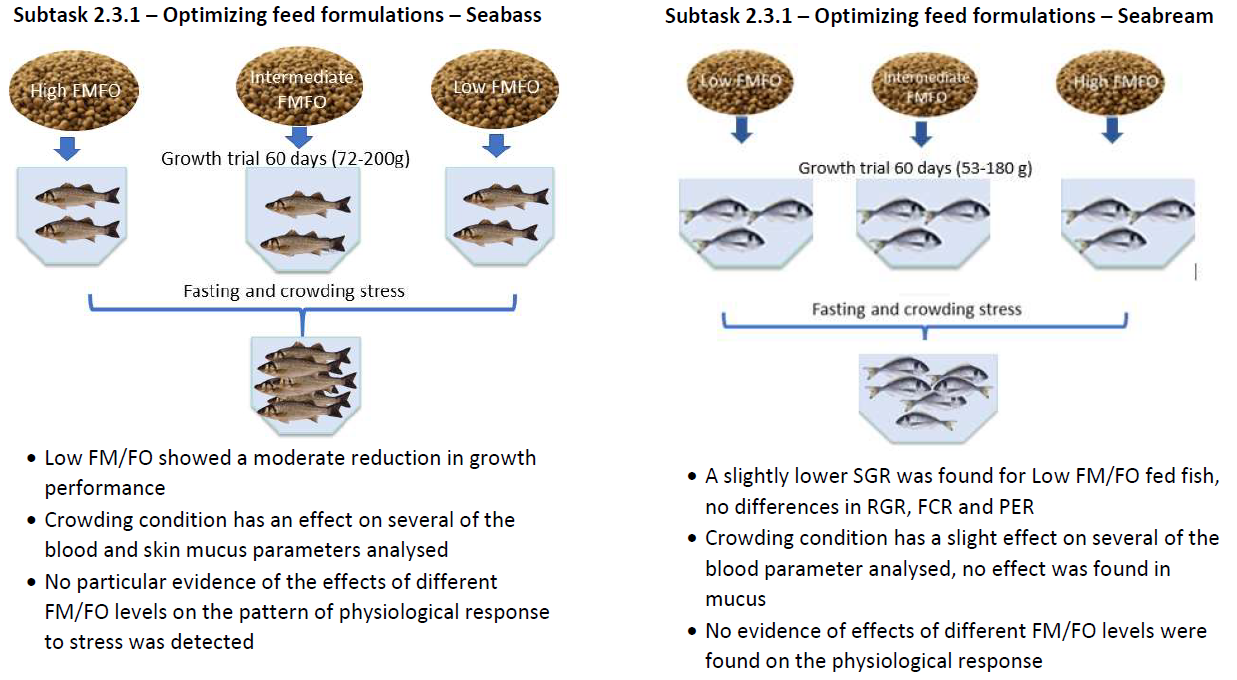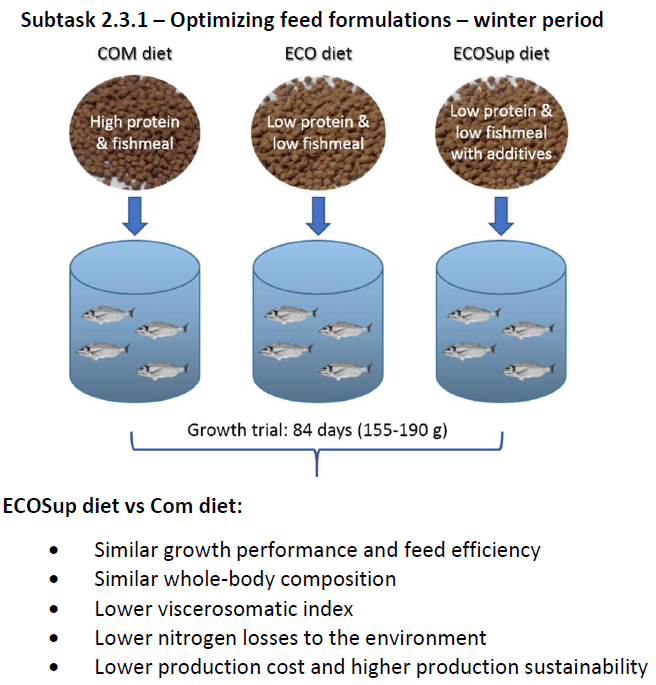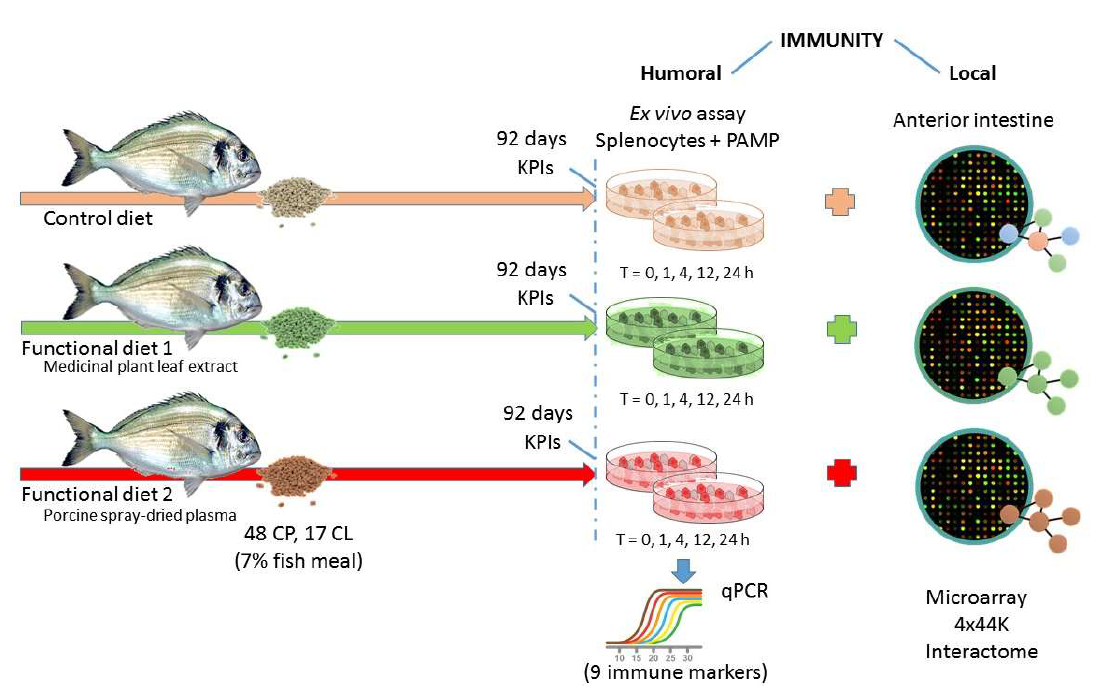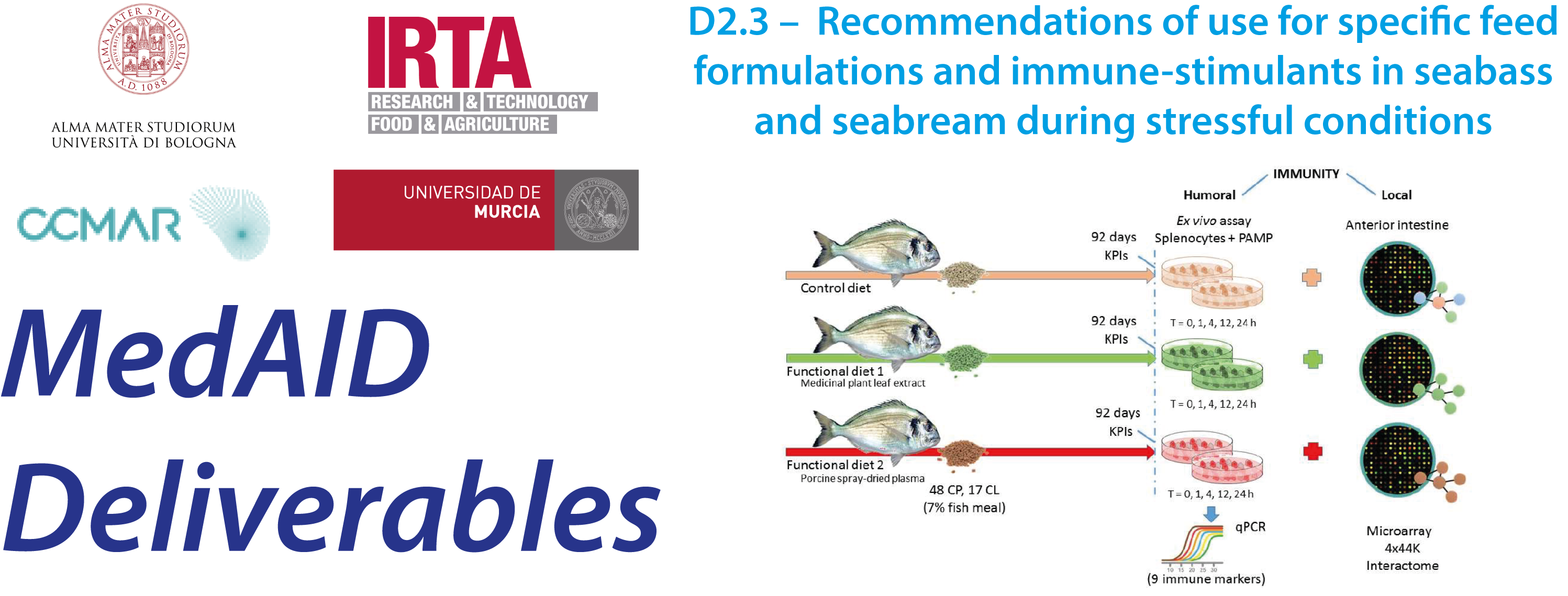MedAID Work Package 2 (Improving Zootechnical Performance) starts from the current context of knowledge in fish nutrition, and considers work on improvement in rearing conditions and feeding strategies fundamental to improve their related Key Performance Indicators (KPIs). This is a multidisciplinary WP that looks for correlations among different parameters related to rearing conditions, environmental factors, feeding, growth, fish health and fish quality. Furthermore cultured fish are often exposed to stresses of different nature, which can cause a wide range of physiological alterations, reducing overall performance and fish welfare. Handling operations (e.g. vaccinations, treatments, grading or transport) can involve fish crowding during short times; fasting periods are a consequence of bad weather conditions, when feeding can be impossible, or to voluntary restrictions before harvesting and slaughtering fish; cold water temperature during winter periods can also challenge fish ability to feed and impose long fasting periods. Task 2.3 of MedAID has investigated different options for reducing fish stress by optimizing feed formulation or using functional feeds.
Deliverable 2.3. reports the results from WP2 Task 2.3. Optimize feeding strategies during unfavourable farming conditions, which aims to reduce feed conversion rate (FCR), improve health and stress tolerance by better rearing and feeding strategies for seabass and seabream juveniles.
Subtask 2.3.1 (Optimizing feed formulations ) evaluated the use of feeds with different fish meal/fish oil (FM/FO, 3 levels: low =10/3, medium= 20/7 and high = 30/15 FM/FO) and digestible protein/digestible energy ratios (DP/DE, two levels: 44%18 and 42/18 plus a diet supplemented with a mix of additives to promote feed intake) on the physiological recovery and stress resistance of the fish when exposed to mid/long term fasting periods, crowding stress or low (winter) temperatures. Two different trials were proposed in the project and the results obtained are summarized in the following figure.
 Results of Subtask 2.3.1 displayed lower growth in fish fed low fishmeal and fish oil (Low FM/FO= 10/3) compared to those fed intermediate (20/7) and high (30/15) fishmeal and fish oil levels. In the case of seabass the differences in growth (SGR: specific growth rate) seem to be related to a slightly lower FCR in low fishmeal and fish oil diets even if differences were not significant. In the case of seabream no differences in FCR or protein efficiency ratio (PER) were found. Although the exposure to crowding had an effect on several blood and skin mucus parameters analysed, there was no particular evidence of the effect of different FM/FO levels on the physiological response to a crowding stress episode.
Results of Subtask 2.3.1 displayed lower growth in fish fed low fishmeal and fish oil (Low FM/FO= 10/3) compared to those fed intermediate (20/7) and high (30/15) fishmeal and fish oil levels. In the case of seabass the differences in growth (SGR: specific growth rate) seem to be related to a slightly lower FCR in low fishmeal and fish oil diets even if differences were not significant. In the case of seabream no differences in FCR or protein efficiency ratio (PER) were found. Although the exposure to crowding had an effect on several blood and skin mucus parameters analysed, there was no particular evidence of the effect of different FM/FO levels on the physiological response to a crowding stress episode.
Concerning the winter experiment, the results show that during challenging periods of seabream ongrowing, the ECOSup (low digestible protein and low FM supplemented) diet containing low protein and fishmeal levels is a valuable alternative to the COM (high digestible protein and high FM) diet, as fish growth performance and feed utilization are similar, while the viscerosomatic index decreases. Moreover, the ECOSup diet includes more sustainable ingredients and minimizes nitrogen losses to the environment, resulting in clear environmental and economic benefits without compromising fish growth performance.
 Subtask 2.3.2 (Functional feeds) evaluated the use of two functional additives in diets containing low levels of fish meal (7%): one feed additive based on an animal by-product obtained from animal blood processing (porcine spray-dried plasma: SDPP), and another diet containing a medicinal plant leaf extract from sage (S. officinalis) and lemon verbena (L. citriodora). Diets (48% protein, 17% lipids; 7% fishmeal) were tested in gilthead seabream for 92 days at 25⁰C. At the end of the trial, growth was evaluated as well as the immune response at humoral and local levels. Local immunity was evaluated by means of transcriptomic profiling of the intestine (microarray analysis), whereas systemic immune responses were evaluated at the gene expression level in splenocytes by a short-term ex vivo stimulation with LPS (lipopolysaccharide), a broadly recognized pathogen-associated molecular pattern that simulates a pathogen infection.
Subtask 2.3.2 (Functional feeds) evaluated the use of two functional additives in diets containing low levels of fish meal (7%): one feed additive based on an animal by-product obtained from animal blood processing (porcine spray-dried plasma: SDPP), and another diet containing a medicinal plant leaf extract from sage (S. officinalis) and lemon verbena (L. citriodora). Diets (48% protein, 17% lipids; 7% fishmeal) were tested in gilthead seabream for 92 days at 25⁰C. At the end of the trial, growth was evaluated as well as the immune response at humoral and local levels. Local immunity was evaluated by means of transcriptomic profiling of the intestine (microarray analysis), whereas systemic immune responses were evaluated at the gene expression level in splenocytes by a short-term ex vivo stimulation with LPS (lipopolysaccharide), a broadly recognized pathogen-associated molecular pattern that simulates a pathogen infection.
 Results of Subtask 2.3.2 showed that both tested diets significantly improved somatic growth performance as well as modulated the immune response in gilthead seabream.
Results of Subtask 2.3.2 showed that both tested diets significantly improved somatic growth performance as well as modulated the immune response in gilthead seabream.
The functional additive based on a leaf plant extract rich in triterpenic and polyphenolic compounds enhanced the non-specific immune response when the host was exposed to LPS (simulation of a pathogen invasion) as shown in the ex vivo experiment with splenocytes. Furthermore, immunity was also enhanced at the local level as data from the transcriptomic analysis (microarray) of the intestinal mucosa indicated. The results indicated that this feed additive, due to its immunomodulatory properties, may be recommended for incorporation in aquafeeds as a prophylactic agent
Regarding the evaluation of the functional diet based on the inclusion of a porcine blood by-product, the spray-dried plasma, we found that the replacement of FM by this ingredient at 5% (nominal FM level in the diet: 2%) enhanced somatic growth and feed efficiency performances, as well as modulated the systemic immune response as indicated by gene expression data from the ex vivo experiment. These results coupled with the functional analysis of differential expressed genes obtained by the microarray analysis of the intestinal mucosa indicated that this ingredient modulated innate immunity processes mediated by leukocytes. Thus, the use of SDPP may be advisable as a promising dietary alternative to be included in diets with low and very low levels of FM, as well as being recommended for further evaluation in functional diets under the presence of biotic or abiotic stressors.
Access to the full deliverable

